

|
<<< Continued from previous page Before Nast's influence, Santa was still viewed as an elf-like creature. This advertising trade card from the 1880s for a Boot and Shoe Store in Pennsylvania shows a diminutive Santa decorating a Christmas tree with cookie stars:
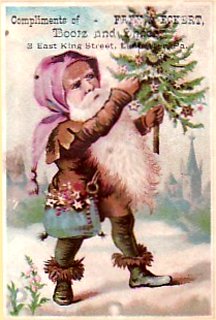
Thomas Nast transformed Santa into a powerful American icon. Nast's first illustration of Santa for Harper's Weekly was the cover for their January 3, 1863 issue and was titled "Santa Claus in Camp." A hearty full sized Santa is dressed in striped pants and fur trimmed jacket with stars, while seated on a sleigh delivering presents to weary Union troops at the front. Thanks to Thomas Nast, Santa's link with American patriotism was a theme that endured well into the 20th century, as seen on this postcard published around 1905:
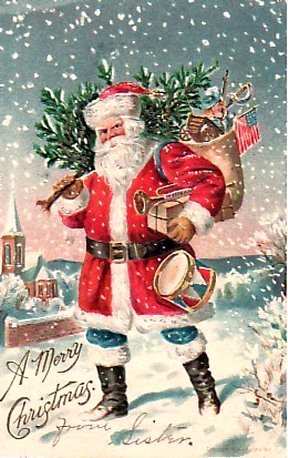
Nast was to continue drawing Santa for twenty-three years, ending the Harper's series in 1886. His greatest contribution to Santa iconography was a double-page spread in 1866 in Harper's titled "Santa Claus - His Works." Nast's kaleidoscopic multi-framed illustration firmly established Santa's residence at the North Pole, where toys were manufactured in cluttered workrooms, children's names and behavior were recorded in a large book, and a large telescope was used by Santa to locate good children. The words "Santa Claussville, N.P." in the corner of the Nast cartoon marked the first time anyone had linked Santa to the North Pole. The burgeoning field of polar exploration had captured the collective imagination of Civil War America, and Santa's North Pole residence was Thomas Nast's unique contribution to the evolution of Santa Claus. As a unique symbol of America, Santa has always reflected current themes in popular culture. His mode of transportation ranges from the traditional reindeer on this 1908 postcard:
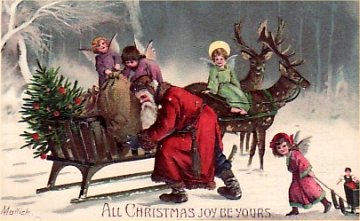
To a donkey in this 1895 McLoughlin Bros. lithographed book:
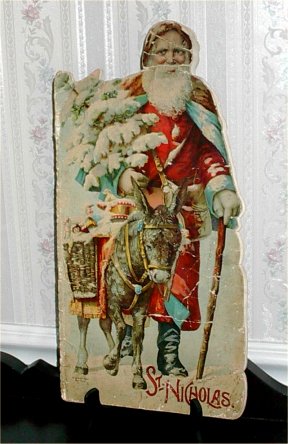
To an auto on this 1916 postcard:
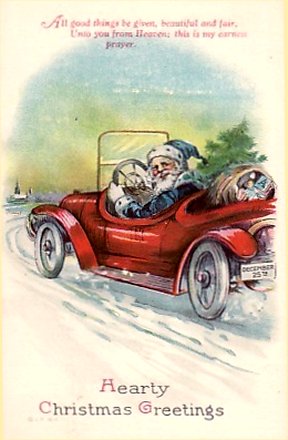
To a 1950s martini glass?

Other notable illustrators of Santa were George Hinke of Ideals Publishing Company of Wisconsin, and, of course, Haddon Sundblom, who was commissioned by the Coca-Cola Company for their annual Christmas illustrations from 1931 to 1968. Sundblom's Coke Santa is now an American icon. (By the way, booksellers may be interested to know that the book Dream of Santa: Haddon Sundblom's Advertising Paintings for Christmas, 1932-1964 was remaindered on its publication in 1992, with copies now selling in the $65 to $190 range.) Through the years, Santa has reflected the goals, dreams and aspirations inherent in American culture. He is shaped by the events around him, just as we are, and his evolution mirrors the evolution of America. One hundred years ago in 1907, Americans were fascinated by the prospect of air travel. This wonderful image of Santa traveling by dirigible is from a 1907 issue of St. Nicholas Magazine. The caption predicts that this will be Santa's mode of transportation 100 years in the future - the year 2007!
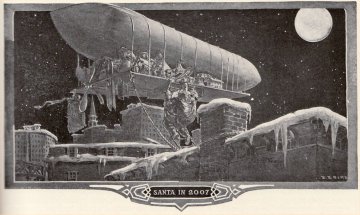
Merry Christmas to all, and to all a good night!
< to previous article to next article >
Questions or comments?
| Forum
| Store
| Publications
| BookLinks
| BookSearch
| BookTopics
| Archives
| Advertise
| AboutUs
| ContactUs
| Search Site
| Site Map
| Google Site Map
Store - Specials
| BookHunt
| BookShelf
| Gold Edition & BookThink's Quarterly Market Report
| DomainsForSale
| BookThinker newsletter - free
Copyright 2003-2011 by BookThink LLC
|

|
|